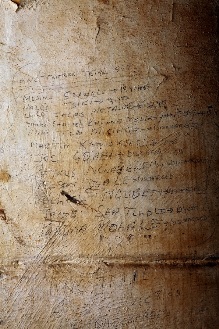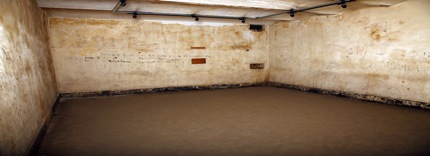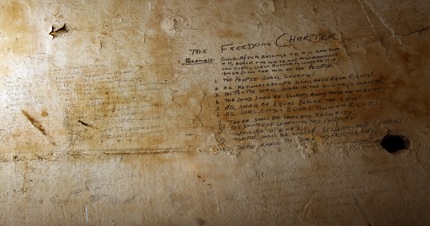
The list of some of the trialists that came through this holding cell, including Tokyo Sexwale
March 9, 2011 – The Palace of Justice was the venue for the historic Rivonia Trial (1964) involving Nelson Mandela. In 2002 the entire interior of the building was renovated, except for the holding cells below ground level. Mandela and his fellow trialists found themselves in one of these cells on every day of the trial. The walls of the cell carry messages left by generations of political prisoners.
An extract from Long Walk to Freedom (pg. 417) describes the context:
“On 9 October 1963, we were picked up in a heavily fortified police van. It had a steel divider running along the centre, segregating the white prisoners from the Africans. We were driven to the Palace of Justice in Pretoria, where the Supreme Court sits, for the opening of ‘The State versus the National High Command and others’, that later become known as ‘The State versus Nelson Mandela and others’, and is still better known as the Rivonia Trial. Near the court stands a statue of Paul Kruger, the president of the Republic of the Transvaal who fought against British imperialism in the nineteenth century. Underneath this Afrikaner hero is a quotation from one of his speeches. The inscription reads: ‘In confidence we lay our cause before the whole world. Whether we win or whether we die, freedom will rise in Africa like the sun from the morning clouds.’
Our van was in the centre of a convoy of police trucks. At the front of this motorcade were limousines carrying high police officials. The Palace of Justice was teeming with armed policemen. To avoid the enormous crowd of our supporters who had grouped in front of the building, we were driven to the rear of the building and taken in through great iron gates. All around the building police officers with machine guns stood at attention. As we descended from the van, we could hear the great crowd singing and chanting. Once inside, we were held in cells below the courtroom before the opening of what was depicted in the newspapers at home and around the world as the most significant political trial in the history of South Africa.”
Images (Click on the image for a larger version)

